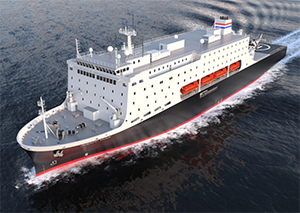The fiscal year 2018 budget enacted by Congress in March includes $300 million for construction of a new training ship for the State University of New York (SUNY) Maritime College, as well as $22 million for maintenance and repair of the rest of the nation’s aging academy fleet.
The first national security multi-mission vessel (NSMV) will replace Empire State VI, the oldest training ship serving the six state maritime academies. In addition to training cadets, the ships are often activated by the government to assist with cleanup and recovery efforts following natural disasters. The U.S. Maritime Administration (MarAd) created the NSMV class for this dual purpose. It commissioned a design in 2015 and is currently gathering bids for construction.
The average age of ships in the academy fleet is about 38 years old. At 56, Empire State VI is the oldest. Originally built as SS Oregon and converted to a training ship in 1989, the 565-foot freighter delivered supplies and housed disaster relief workers after hurricanes Katrina, Irma, Maria and Sandy. A spokesman said MarAd’s fiscal year 2019 budget request includes another $300 million for a second NSMV to replace the 51-year-old Kennedy at Massachusetts Maritime Academy.
“The ships are absolutely essential to our training,” said Capt. Mark Woolley, chief of staff for SUNY Maritime. “It’s how our cadets get their required sea time.”
Cadets set sail for three “sea terms” that last between 45 and 90 days. They rotate through onboard classes and laboratory training, learning about ships’ operations, deck and engine watches, emergency drills and maintenance.
The Trump administration’s initial FY 2018 budget proposed $300 million to purchase and refurbish two used ships for the academies, which produce more than 70 percent of U.S.-licensed Coast Guard officers annually. In the past, MarAd reassigned and refurbished ships from the National Defense Reserve Fleet for academy use, but no current reserve ships fit the bill.
During a February hearing, MarAd Administrator Mark Buzby said the administration would search the international market for suitable ships, but members of the House Subcommittee on Coast Guard and Maritime Transportation pushed back on the idea of buying secondhand vessels from foreign nations.
“In the long run, new construction is a better choice,” Woolley said. “They’ll be built from the keel up, and they’re designed not just for training but for disaster assistance. The new vessels will allow cadets to train on the latest technology, and they will reduce the economic burden of maintaining an aging ship.”
Empire State VI, like most of the training fleet, uses outdated engine and navigation technology, and many of the ships still rely on steam propulsion. Last year, SUNY Maritime replaced the bridge and electronic navigation equipment on the ship.
“You have to put a lot of money in, and each of the ships is different,” Woolley said. “Once you get a ship that’s past 20 or 30 years old, good luck trying to find parts for it. The maintenance costs on these ships is going up each year we keep them.”
Woolley said MarAd expects the new ship to be built and delivered by late 2021, with the first training cruise planned for the following year.

